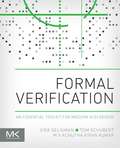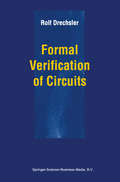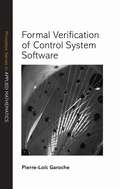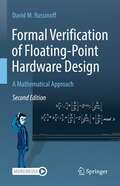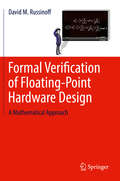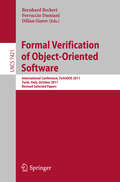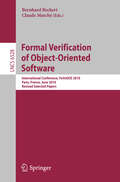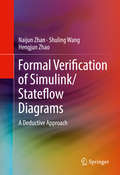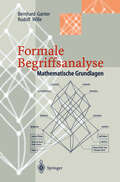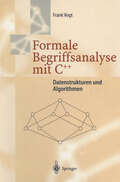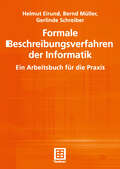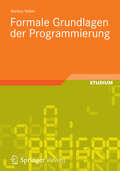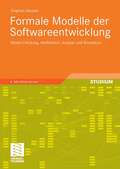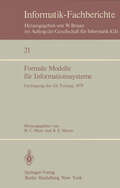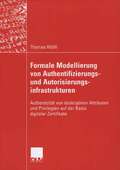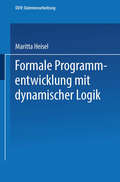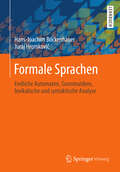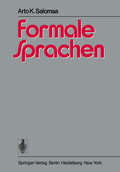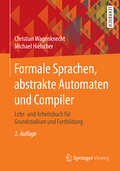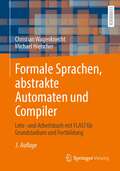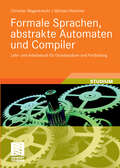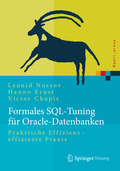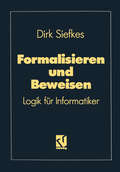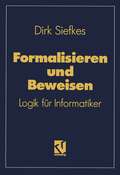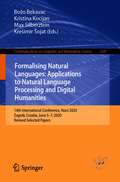- Table View
- List View
Formal Verification: An Essential Toolkit for Modern VLSI Design
by Erik Seligman Tom Schubert M V KumarFormal Verification: An Essential Toolkit for Modern VLSI Design presents practical approaches for design and validation, with hands-on advice to help working engineers integrate these techniques into their work. Formal Verification (FV) enables a designer to directly analyze and mathematically explore the quality or other aspects of a Register Transfer Level (RTL) design without using simulations. This can reduce time spent validating designs and more quickly reach a final design for manufacturing. Building on a basic knowledge of SystemVerilog, this book demystifies FV and presents the practical applications that are bringing it into mainstream design and validation processes at Intel and other companies. After reading this book, readers will be prepared to introduce FV in their organization and effectively deploy FV techniques to increase design and validation productivity.Learn formal verification algorithms to gain full coverage without exhaustive simulationUnderstand formal verification tools and how they differ from simulation toolsCreate instant test benches to gain insight into how models work and find initial bugsLearn from Intel insiders sharing their hard-won knowledge and solutions to complex design problems
Formal Verification of Circuits
by Rolf DrechslerFormal verification has become one of the most important steps in circuit design. Since circuits can contain several million transistors, verification of such large designs becomes more and more difficult. Pure simulation cannot guarantee the correct behavior and exhaustive simulation is often impossible. However, many designs, like ALUs, have very regular structures that can be easily described at a higher level of abstraction. For example, describing (and verifying) an integer multiplier at the bit-level is very difficult, while the verification becomes easy when the outputs are grouped to build a bit-string. Recently, several approaches for formal circuit verification have been proposed that make use of these regularities. These approaches are based on Word-Level Decision Diagrams (WLDDs) which are graph-based representations of functions (similar to BDDs) that allow for the representation of functions with a Boolean range and an integer domain. Formal Verification of Circuits is devoted to the discussion of recent developments in the field of decision diagram-based formal verification. Firstly, different types of decision diagrams (including WLDDs) are introduced and theoretical properties are discussed that give further insight into the data structure. Secondly, implementation and minimization concepts are presented. Applications to arithmetic circuit verification and verification of designs specified by hardware description languages are described to show how WLDDs work in practice. Formal Verification of Circuits is intended for CAD developers and researchers as well as designers using modern verification tools. It will help people working with formal verification (in industry or academia) to keep informed about recent developments in this area.
Formal Verification of Control System Software (Princeton Series in Applied Mathematics #67)
by Pierre-Loïc GarocheAn essential introduction to the analysis and verification of control system softwareThe verification of control system software is critical to a host of technologies and industries, from aeronautics and medical technology to the cars we drive. The failure of controller software can cost people their lives. In this authoritative and accessible book, Pierre-Loïc Garoche provides control engineers and computer scientists with an indispensable introduction to the formal techniques for analyzing and verifying this important class of software.Too often, control engineers are unaware of the issues surrounding the verification of software, while computer scientists tend to be unfamiliar with the specificities of controller software. Garoche provides a unified approach that is geared to graduate students in both fields, covering formal verification methods as well as the design and verification of controllers. He presents a wealth of new verification techniques for performing exhaustive analysis of controller software. These include new means to compute nonlinear invariants, the use of convex optimization tools, and methods for dealing with numerical imprecisions such as floating point computations occurring in the analyzed software.As the autonomy of critical systems continues to increase—as evidenced by autonomous cars, drones, and satellites and landers—the numerical functions in these systems are growing ever more advanced. The techniques presented here are essential to support the formal analysis of the controller software being used in these new and emerging technologies.
Formal Verification of Floating-Point Hardware Design: A Mathematical Approach
by David M. RussinoffThis is the first book to focus on the problem of ensuring the correctness of floating-point hardware designs through mathematical methods. Formal Verification of Floating-Point Hardware Design, Second Edition advances a verification methodology based on a unified theory of register-transfer logic and floating-point arithmetic that has been developed and applied to the formal verification of commercial floating-point units over the course of more than two decades, during which the author was employed by several major microprocessor design companies. The theory is extended to the analysis of several algorithms and optimization techniques that are commonly used in commercial implementations of elementary arithmetic operations. As a basis for the formal verification of such implementations, high-level specifications of the basic arithmetic instructions of several major industry-standard floating-point architectures are presented, including all details pertaining to the handling of exceptional conditions. The methodology is illustrated in the comprehensive verification of a variety of state-of-the-art commercial floating-point designs developed by Arm Holdings. This revised edition reflects the evolving microarchitectures and increasing sophistication of Arm processors, and the variation in the design goals of execution speed, hardware area requirements, and power consumption. Many new results have been added to Parts I—III (Register-Transfer Logic, Floating-Point Arithmetic, and Implementation of Elementary Operations), extending the theory and describing new techniques. These were derived as required in the verification of the new RTL designs described in Part V.
Formal Verification of Floating-Point Hardware Design: A Mathematical Approach
by David M. Russinoff J Strother MooreThis is the first book to focus on the problem of ensuring the correctness of floating-point hardware designs through mathematical methods. Formal Verification of Floating-Point Hardware Design advances a verification methodology based on a unified theory of register-transfer logic and floating-point arithmetic that has been developed and applied to the formal verification of commercial floating-point units over the course of more than two decades, during which the author was employed by several major microprocessor design companies. The book consists of five parts, the first two of which present a rigorous exposition of the general theory based on the first principles of arithmetic. Part I covers bit vectors and the bit manipulation primitives, integer and fixed-point encodings, and bit-wise logical operations. Part II addresses the properties of floating-point numbers, the formats in which they are encoded as bit vectors, and the various modes of floating-point rounding. In Part III, the theory is extended to the analysis of several algorithms and optimization techniques that are commonly used in commercial implementations of elementary arithmetic operations. As a basis for the formal verification of such implementations, Part IV contains high-level specifications of correctness of the basic arithmetic instructions of several major industry-standard floating-point architectures, including all details pertaining to the handling of exceptional conditions. Part V illustrates the methodology, applying the preceding theory to the comprehensive verification of a state-of-the-art commercial floating-point unit. All of these results have been formalized in the logic of the ACL2 theorem prover and mechanically checked to ensure their correctness. They are presented here, however, in simple conventional mathematical notation. The book presupposes no familiarity with ACL2, logic design, or any mathematics beyond basic high school algebra. It will be of interest to verification engineers as well as arithmetic circuit designers who appreciate the value of a rigorous approach to their art, and is suitable as a graduate text in computer arithmetic.
Formal Verification of Object-Oriented Software: International Conference, FoVeOO 2011, Turin, Italy, October 5-7, 2011, Revised Selected Papers (Lecture Notes in Computer Science #7421)
by Bernhard Beckert Ferruccio Damiani Dilian GurovThis book presents the thoroughly refereed post-conference proceedings of the International Conference on Formal Verification of Object-Oriented Software, FoVeOOS 2011, held in Turin, Italy, in October 2011 – organised by COST Action IC0701. The 10 revised full papers presented together with 5 invited talks were carefully reviewed and selected from 19 submissions. Formal software verification has outgrown the area of academic case studies, and industry is showing serious interest. The logical next goal is the verification of industrial software products. Most programming languages used in industrial practice are object-oriented, e.g. Java, C++, or C#. FoVeOOS 2011 aimed to foster collaboration and interactions among researchers in this area.
Formal Verification of Object-Oriented Software: International Conference, FoVeOOS 2010, Paris, France, June 28-30, 2010, Revised Selected Papers (Lecture Notes in Computer Science #6528)
by Bernhard Beckert Claude MarchéThis book presents the thoroughly refereed post-conference proceedings of the International Conference on Formal Verification of Object-Oriented Software, FoVeOOS 2010, held in Paris, France, in June 2010 - organised by COST Action IC0701. The 11 revised full papers presented together with 2 invited talks were carefully reviewed and selected from 21 submissions. Formal software verification has outgrown the area of academic case studies, and industry is showing serious interest. The logical next goal is the verification of industrial software products. Most programming languages used in industrial practice are object-oriented, e.g. Java, C++, or C#. FoVeOOS 2010 aimed to foster collaboration and interactions among researchers in this area.
Formal Verification of Simulink/Stateflow Diagrams: A Deductive Approach
by Naijun Zhan Shuling Wang Hengjun ZhaoThis book presents a state-of-the-art technique for formal verification of continuous-time Simulink/Stateflow diagrams, featuring an expressive hybrid system modelling language, a powerful specification logic and deduction-based verification approach, and some impressive, realistic case studies. Readers will learn the HCSP/HHL-based deductive method and the use of corresponding tools for formal verification of Simulink/Stateflow diagrams. They will also gain some basic ideas about fundamental elements of formal methods such as formal syntax and semantics, and especially the common techniques applied in formal modelling and verification of hybrid systems. By investigating the successful case studies, readers will realize how to apply the pure theory and techniques to real applications, and hopefully will be inspired to start to use the proposed approach, or even develop their own formal methods in their future work.
Formale Begriffsanalyse: Mathematische Grundlagen
by Bernhard Ganter Rudolf WilleDieses erste Lehrbuch zur Formalen Begriffsanalyse gibt eine systematische Darstellung der mathematischen Grundlagen und ihrer Verbindung zu Anwendungen in der Informatik, insbesondere in der Datenanalyse und Wissensverarbeitung. Das Buch vermittelt vor allem Methoden der graphischen Darstellung von Begriffssystemen, die sich in der Wissenskommunikation bestens bewährt haben. Theorie und graphische Darstellung werden dabei eng miteinander verknüpft. Die mathematischen Grundlagen werden vollständig abgehandelt und durch zahlreiche Beispiele anschaulich gemacht. Da zur Wissensverarbeitung immer stärker der Computer genutzt wird, gewinnen formale Methoden begrifflicher Analyse überall an Bedeutung. Das Buch macht die dafür grundlegende Theorie in kompakter Form zugänglich.
Formale Begriffsanalyse mit C++: Datenstrukturen und Algorithmen
by Frank VogtDas Buch soll den Leser, der an Formaler Begriffsanalyse als Methode der Datenanalyse und Wissenstrukturierung interessiert ist, in die Lage versetzen, eigene C++-Programme zur Formalen Begriffsanalyse zu schreiben. Die C++-Klassenbibliothek wird in Aufbau und Benutzung ausführlich anhand zahlreicher Beispiele sowie den zugrunde liegenden mathematischen Begriffen diskutiert. Die Vorgehensweisen der Formalen Begriffsanalyse werden an einem Anwendungsbeispiel erläutert, so daß das Buch sowohl als Leitfaden für den interessierten Neueinsteiger als auch als Handbuch für den versierten Anwendungsprogrammierer und Projektleiter dienen kann. Der Quellcode der aktuellen Version der C++-Bibliothek findet man auf dem Internet.
Formale Beschreibungsverfahren der Informatik: Ein Arbeitsbuch für die Praxis (Informatik & Praxis)
by Helmut Eirund Bernd Müller Gerlinde SchreiberBeschreibungsformalismen aus der theoretischen Informatik werden benutzt, um Systeme präzise zu beschreiben. Diese Formalismen werden in vielen Gebieten des praktischen Systementwurfs angewandt. Das Buch stellt die wichtigsten, grundlegenden Formalismen zusammen und kompensiert damit das in den sog. Bindestrich-Informatik-Studiengängen an Fachhochschulen typischerweise anzutreffende Defizit in diesem Bereich.
Formale Grundlagen der Programmierung (Studienbücher Informatik)
by Markus NebelKompakt und leicht verständlich führt dieses Lehrbuch in die formalen Grundlagen der Programmierung ein. Von dr Syntax über Semantik und Verifikation bis hin zur Brechenbarkeit werden alle relevanten Themen fundiert dargestellt.
Formale Modelle der Softwareentwicklung: Model-Checking, Verifikation, Analyse und Simulation
by Stephan KleukerSoftware muss funktionieren, um von Kunden akzeptiert zu werden. Doch wie stellt man sicher, dass die Steuerung eines Raumschiffs, eines Herzschrittmachers oder einer Aktienverwaltung korrekt funktioniert? Neben den klassischen Testansätzen spielen für den Korrektheitsnachweis zunehmend formale Modelle eine zentrale Rolle. Ein Modell erlaubt es, ein beliebiges sequenzielles oder verteiltes System zu analysieren und zu simulieren. Dadurch, dass Korrektheitsanforderungen präzise definiert werden, kann man sogar verifizieren, dass die Anforderungen erfüllt sind. Dieses Buch stellt unterschiedliche formale Modelle mit ihren Einsatzmöglichkeiten und Werkzeugen vor. Dabei steht bewusst die Anwendung der Modelle und nicht die Theorie dahinter im Vordergrund.
Formale Modelle für Informationssysteme: GI-Fachtagung, 24.–26. Mai 1979, Tutzing (Informatik-Fachberichte #21)
by H. C. Mayr B. E. MeyerFormale Modellierung von Authentifizierungs- und Autorisierungsinfrastrukturen: Authentizität von deskriptiven Attributen und Privilegien auf der Basis digitaler Zertifikate
by Thomas WölflThomas Wölfls Modell erlaubt erstmals neben der Herleitung von Schlüsselauthentizität auch die Ableitung von Attributauthentizität und umfasst Gültigkeitsdauer und Rückruf von digitalen Zertifikaten. So kann die Echtheit von Zugriffsprivilegien und deskriptiven Attributen für einen bestimmten Zeitpunkt formal bewiesen werden. Das vom Autor entwickelte PROLOG-Programm ermöglicht eine automatisierte Ableitung, liefert nachweislich korrekte Ergebnisse und terminiert.
Formale Sprachen: Endliche Automaten, Grammatiken, lexikalische und syntaktische Analyse
by Hans-Joachim Böckenhauer Juraj HromkovicDieses Lehrbuch mit detailliert ausgearbeiteten Erklärungen und auf die Zielsetzungen fein abgestimmtem Training bietet einen einfachen Einstieg in die Theorie der formalen Sprachen. Es eignet sich gut für den Unterricht und das Selbststudium. Neben Gymnasiasten und Studienanfängern an Hochschulen richtet es sich auch an Lehramtsstudierende, insbesondere wenn sie sich mit der praktischen Umsetzung der Fachdidaktik für die Unterrichtsvorbereitung beschäftigen.Inhaltlich liegt der Fokus auf endlichen Automaten zur Systemsteuerung und zur Mustererkennung in Texten sowie auf Grammatiken zur Beschreibung von Programmiersprachen. Weiter werden erste Schritte im Compilerbau (lexikalische und syntaktische Analyse) unternommen.Die Leserinnen und Leser werden zur Bearbeitung von Projekten zur Darstellung und Analyse einfacher Programmiersprachen eingeladen.
Formale Sprachen, abstrakte Automaten und Compiler: Lehr- und Arbeitsbuch für Grundstudium und Fortbildung
by Christian Wagenknecht Michael HielscherDie eher abstrakten Inhalte der Theoretischen Informatik werden aus praktischen Anwendungsbeispielen heraus motiviert, anschaulich vermittelt und in Übungen vertieft. Durch das gesamte Buch hindurch zieht sich das Vorhaben, einen Compiler für eine Sprache mit grafischen Effekten herzustellen. An den entsprechenden Stellen werden die dafür notwendigen Beiträge erarbeitet und Aspekte automatisierter Compilergenerierung thematisiert. Zur Modellierung formaler Sprachen, regulärer Ausdrücke, abstrakter Automaten und zur automatisierten Compilergenerierung aus einer grafisch-visuellen Beschreibung stellt AtoCC miteinander vernetzte Komponenten zur Verfügung. Die Lern- und Arbeitsumgebung AtoCC wurde speziell für das Studium der theoretischen Informatik entwickelt und bereits an mehreren Hochschulen und Schulen erfolgreich eingesetzt. AtoCC vertieft Theoriewissen durch praktische Übungen und attraktive Anwendungsprojekte aus dem Grafik- und Audiobereich. Übersetzung und Verarbeitung mehr oder weniger komplexer Sprachen finden wir heute beispielsweise auch in modernen Web-Applikationen.
Formale Sprachen, abstrakte Automaten und Compiler: Lehr- und Arbeitsbuch mit FLACI für Grundstudium und Fortbildung
by Christian Wagenknecht Michael HielscherDie eher abstrakten Inhalte der Theoretischen Informatik werden aus praktischen Anwendungsbeispielen heraus motiviert, anschaulich vermittelt und in Übungen vertieft. Durch das gesamte Buch hindurch zieht sich das Vorhaben, einen Compiler für eine Sprache mit grafischen Effekten herzustellen. An den entsprechenden Stellen werden die dafür notwendigen Beiträge erarbeitet und Aspekte automatisierter Compilergenerierung thematisiert. Zur Definition und Simulation formaler Sprachen mit regulären Ausdrücken, formalen Grammatiken und abstrakten Automaten sowie zur automatisierten Compilergenerierung aus einer grafisch-visuellen Beschreibung stellt die Lern- und Arbeitsumgebung FLACI miteinander vernetzte Komponenten zur Verfügung. Da es sich um eine Web-Anwendung (ohne JAVA) handelt, entfällt jeglicher Installations- und Aktualisierungsaufwand. FLACI wurde speziell für das Studium der theoretischen Informatik entwickelt und bereits an mehreren Hochschulen und Schulen erfolgreich eingesetzt. FLACI vertieft Theoriewissen durch praktische Übungen und attraktive Anwendungsprojekte aus dem Grafik- und Audiobereich. Übersetzung und Verarbeitung mehr oder weniger komplexer Sprachen finden wir heute beispielsweise auch in modernen Web-Applikationen.
Formale Sprachen, abstrakte Automaten und Compiler: Lehr- und Arbeitsbuch für Grundstudium und Fortbildung
by Christian Wagenknecht Michael HielscherDie eher abstrakten Inhalte der Theoretischen Informatik werden aus praktischen Anwendungsbeispielen heraus motiviert, vermittelt und in Übungen mit Anwendungsbezug vertieft. Dabei werden vor allem Aspekte automatisierter Compilergenerierung thematisiert. Übersetzung und Verarbeitung mehr oder weniger komplexer Sprachen finden wir heute beispielsweise in modernen Web-Applikationen. Es gibt vielfältige sehr interessante Beispiele auch im Grafik- und Audiobereich, die sich durch "Belebung" abstrakter Konzepte umsetzen lassen. Die Lern- und Arbeitsumgebung AtoCC hilft dabei, zu attraktiven lauffähigen Programmen zu kommen.
Formales SQL-Tuning für Oracle-Datenbanken: Praktische Effizienz - effiziente Praxis (Xpert.press)
by Leonid Nossov Hanno Ernst Victor ChupisDas Ziel des SQL-Tunings ist eine Verbesserung des bestehenden Ausführungsplans. Die in diesem Buch beschriebene Methode kann man „Bremsenbeseitigung im Ausführungsplan“ nennen. Solche „Bremsen“ oder Engpässe lassen sich durch eine formale Analyse des Ausführungsplans erkennen. Dafür sind keine Datenmodellkentnisse notwendig. Das ist besonders vorteilhaft für Datenbankadministratoren, weil sie in der Regel gar nicht oder unzureichend gut mit dem Datenmodell vertraut sind. Im Buch werden zahlreiche praktische Erfahrungen mit dieser Methode präsentiert.
Formalisieren und Beweisen: Logik für Informatiker (Lehrbuch Informatik)
by Dirk SiefkesGregory Bateson -Biologe, Anthropologe, Psychiater, Systemtheoretiker -erzählt in der Ein l leitung zu seinem Buch Geist und Natur eine Geschichte: Ein Mann gibt in seinen Computer die Frage ein: "Wirst Du jemals denken wie ein Mensch? Rechne mal nach!" Der Computer rechnet und rechnet und gibt schließlich aus: Dabei fallt mir eine Geschichte ein. Die Geschichte dieses Buches handelt von Menschen. "Fangt doch jeden Abschnitt mit einem Beispiel an", schlug Ralf-Detlef Kutsche vor, als er mir 1982 zusammen mit Peter Padawitz, Simone Pribbenow und Andreas Schulze half, die Lehrveranstaltung Logik für Informatiker durchzuführen. "Fragen und Aufgaben regen besser zum Arbeiten an als Begriffe und Sätze. " Deswegen beginnt jeder Teil dieses Buches mit einer Geschichte, die als Arbeitsmaterial dient: Die Einführung mit dem Problem des Affen mit der Banane, die Aussagenlogik mit der Ballwurf logelei, die Offene Prädikatenlogik mit dem Architektenbeispiel und die volle Prädikatenlogik mit der Geometrie Euklids. Deswegen endet jeder Abschnitt mit Aufgaben und Fragen, die wesentlich fürs Verstehen sind. Deswegen sieht man beim Blättern so wenig Beweise: Ich ent wickle einen Beweis lieber aus einer Fragestellung und formuliere das Ergebnis als Satz, statt mit dem Satz zu beginnen. Deswegen sind die Themen des Buches Formalisieren und Verstehen, Tätigkeiten, und nicht Logik und Informatik, Gebiete. Ich behandle in dem Buch im wesentlichen die klassischen Grundthemen der mathematischen Logik: logische Folgerung, Ableitung, Vollständigkeit, logische Theorie, Axiomensystem. Es geht mir aber nicht darum, diese Begriffe und ihre Eigenschaften darzustellen.
Formalising Natural Languages: 14th International Conference, NooJ 2020, Zagreb, Croatia, June 5–7, 2020, Revised Selected Papers (Communications in Computer and Information Science #1389)
by Božo Bekavac Kristina Kocijan Max Silberztein Krešimir ŠojatThis book constitutes selected revised papers of the 14th International Conference, NooJ 2020, held Zagreb, Croatia, in June 2020. Due to the COVID-19 pandemic the conference was held online. NooJ is a linguistic development environment that allows linguists to formalize several levels of linguistic phenomena. NooJ provides linguists with tools to develop dictionaries, regular grammars, context-free grammars, context-sensitive grammars and unrestricted grammars as well as their graphical equivalent to formalize each linguistic phenomenon. The 20 full papers presented were carefully reviewed and selected from 68 submissions. The papers are organized in the following topics: Linguistic Formalization; Digital Humanities and Teaching with NooJ; Natural Language Processing Applications.
